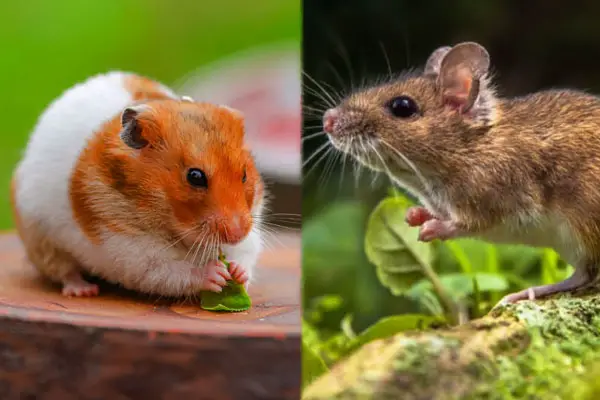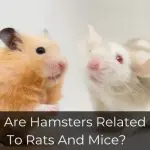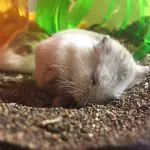Hamster Vs. Mouse: Which Is The Best Small Pet For Your Home?
Hamsters and mice are two popular choices for small pets. While they may look similar, several key differences between these furry creatures make them unique.
So, hamster vs. mouse: which is the best small pet for your home? Your lifestyle and preferences ultimately determine the decision between a hamster and a mouse. Hamsters are low-maintenance pets that are generally calm and do not require much attention. On the other hand, mice are more energetic and social animals who enjoy associating with their owners.
Read on to learn more about the comparison between hamsters and mice comprehensively, whether it’s their appearance, habitat, diet, or behavior.
Comparison of Hamsters Vs. Mice: Overview
Here is a table showing a full comparison between a hamster and a mouse.
| Hamster | Mouse | |
|---|---|---|
| Appearance and size | 2-8 inches long with a short tail | 3-5 inches long with a long tail |
| Behavior | Solitary; nocturnal; less social | Social; nocturnal; more active and curious |
| Odor | Less pungent | More pungent |
| Diet | Serving of 1-2 teaspoons a day | Serving of 1 teaspoon per day |
| Habitat | Prefer single-level cages with plenty of bedding and hiding places | Prefer multi-level cages with plenty of space to climb and explore |
| Handling and care | Less skittish, so they are easy to handle | More difficult to handle because of their small size and skittish nature |
Hamster Vs. Mouse: Understanding The Differences
Here is an in-depth comparison of all the differences between hamsters and mice.

1. Appearance And Size
Hamsters are small and chubby, with short legs and short furry tails. They have large eyes and wide ears.
There are numerous hamster breeds, each with its appearance, size, and coloration. A Syrian hamster, for example, can grow to be 8 inches long, whereas a dwarf hamster is only about 2 inches long.

Mice, on the other hand, are significantly smaller and leaner than hamsters. They have pointed snouts, huge ears, and long tails.
There are numerous mouse breeds. However, they all have similar morphological characteristics. A house mouse’s length, including the tail, is approximately 3 to 5 inches.
2. Behavior
Hamsters are solitary creatures who dislike sharing their dwelling place with other hamsters. They are also violent against other animals and can be territorial. Hamsters in captivity require plenty of opportunities to exercise, explore, and play.

On the other hand, mice are social animals and can live in groups of up to 12 mice. They are curious and amiable animals who like connecting with their owners.
3. Odor
The odor of hamsters and mice is one of the most noticeable differences. While both animals produce a natural scent, mice tend to have a stronger odor than hamsters.
This is because mice have more scent glands than hamsters. Furthermore, mice typically mark their territory, which might contribute to a greater odor.
4. Diet
Both hamsters and mice are omnivores, meaning they can eat a wide variety of things, such as seeds, nuts, fruits, insects, and small mammals.

However, the appropriate serving sizes differ depending on the type of animal. For instance, you should provide 1 to 2 teaspoons of dried commercial food mix daily for a hamster. For a mouse, a single teaspoon of food per day is sufficient, in addition to any treats you offer.
5. Habitat
Hamsters prefer to live in enclosed environments such as cages or aquariums and require at least 360 square inches of floor area. They also require a wheel for exercise and toys to play with.

Mice require more space and a more stimulating habitat than hamsters since they are more gregarious and active. Cages can be used, but a bigger enclosure, such as a terrarium or wire pen, is preferable.
6. Handling and Care
Hamsters are often easier to handle than mice since they are less skittish and more willing to be held. Mice, on the other hand, are more active and interested than hamsters, but due to their small size and skittish nature, they might be more difficult to handle.
Here is a video showing you an in-depth comparison between a hamster and a mouse to help you understand better.
Pros And Cons Of Owning A Hamster Vs. A Mouse
Both hamsters and mice make excellent pets, but each has its own advantages and disadvantages. Here are the pros and cons of owning a hamster.
Pros Of Owning A Hamster
- Hamsters are low-maintenance pets that don’t require much attention
- They are quiet and create little noise, making them ideal for apartment life
- Hamsters are adorable and entertaining to watch

Cons
- Hamsters are solitary animals making them less interactive than other pets
- They have a limited lifespan, typically between 2 and 3 years
The following are the pros and cons of having a mouse as a pet.
Pros Of Owning A Mouse
- Mice enjoy socializing with their owners and other mice
- They are simple to train and can learn tricks and their names
- Mice live longer, typically 2 to 5 years

Cons
- They can be noisy at night
- Mice have a musky odor
Which Is The Better Pet: A Hamster Or A Mouse?
When choosing between a hamster and a mouse as a pet, certain factors can help make the decision easier.
When To Go For A Hamster
Here are some instances where going for a hamster is the best option.

- When you want a low-maintenance pet: A hamster may be a better choice if you want a low-maintenance pet that does not demand much attention. They are less social than mice and do not require as much interaction.
- When you want a pet that is easier to handle: A hamster may be a better choice if you want a pet that is easy to handle and less prone to bite. Hamsters are generally more docile than mice, and when handled, they are less prone to become upset or aggressive.
- When you want a pet that is active during the day: A hamster may be a better choice if you want a pet that is active during the day and rests at night. Hamsters are diurnal creatures.
- When you want a variety of options: A hamster may be a better choice if you want a pet with a selection of breeds. There are various hamster breeds, each with distinct features and appearances, allowing you to select a pet that best fits your personality and lifestyle.
When To Go For A Mouse
If you would instead go for a mouse, there are instances where it would be best to do so, and they include the following.

- When you want a friendly and engaged pet: Mice are more social than hamsters and love interacting with their owners, making them an excellent choice for anyone looking for a more exciting pet.
- When you want a more intelligent pet: Mice are quick learners that enjoy exploring their surroundings, making them ideal pets if you want a pet you can train and play with.
- When you want a pet that is better suited for groups: Mice are social animals that flourish in groups, making them an excellent choice for those who want to have several pets. Mice can coexist in a shared habitat, making them an excellent choice if you want a pet that can mingle with others of its species.
- When you want a more active and playful pet: Mice are incredibly energetic and fun pets with a lot of energy that keeps them interested and entertained. They like exploring their surroundings, climbing and running, and a range of toys and activities to keep them entertained.
FAQs
Here are a few more related questions you might be interested in.
Q1: What are the differences in diet requirements between hamsters and mice?
There is almost no difference between the diet requirements of a hamster and a mouse. They are both omnivores and require a diet of seeds, vegetables, and small mammals. The only difference comes in the serving requirements of each rodent.
Q2: Do hamsters bite more than mice?
Both hamsters and mice have the potential to bite if they feel threatened or stressed. On the other hand, the likelihood of being bitten is mainly determined by the particular animal’s personality and level of socialization.
Q3: What is the best small pet for a kid?
Age, personality, and level of responsibility determine the best small pet for a child. Hamsters and mice are popular tiny pets for children, although gerbils and guinea pigs may also be ideal.
Conclusion
There are some key differences between a hamster vs. mouse, such as their appearance, habitat, diet, and behavior. While both make excellent pets, selecting the one best fits your lifestyle and interests is critical.
Hamsters are low-maintenance pets that don’t require much attention, whereas mice are social creatures who like connecting with their owners. Whatever you decide, ensure they have a clean and pleasant living space, a balanced diet, and frequent veterinary check-ups to ensure their health and well-being.




